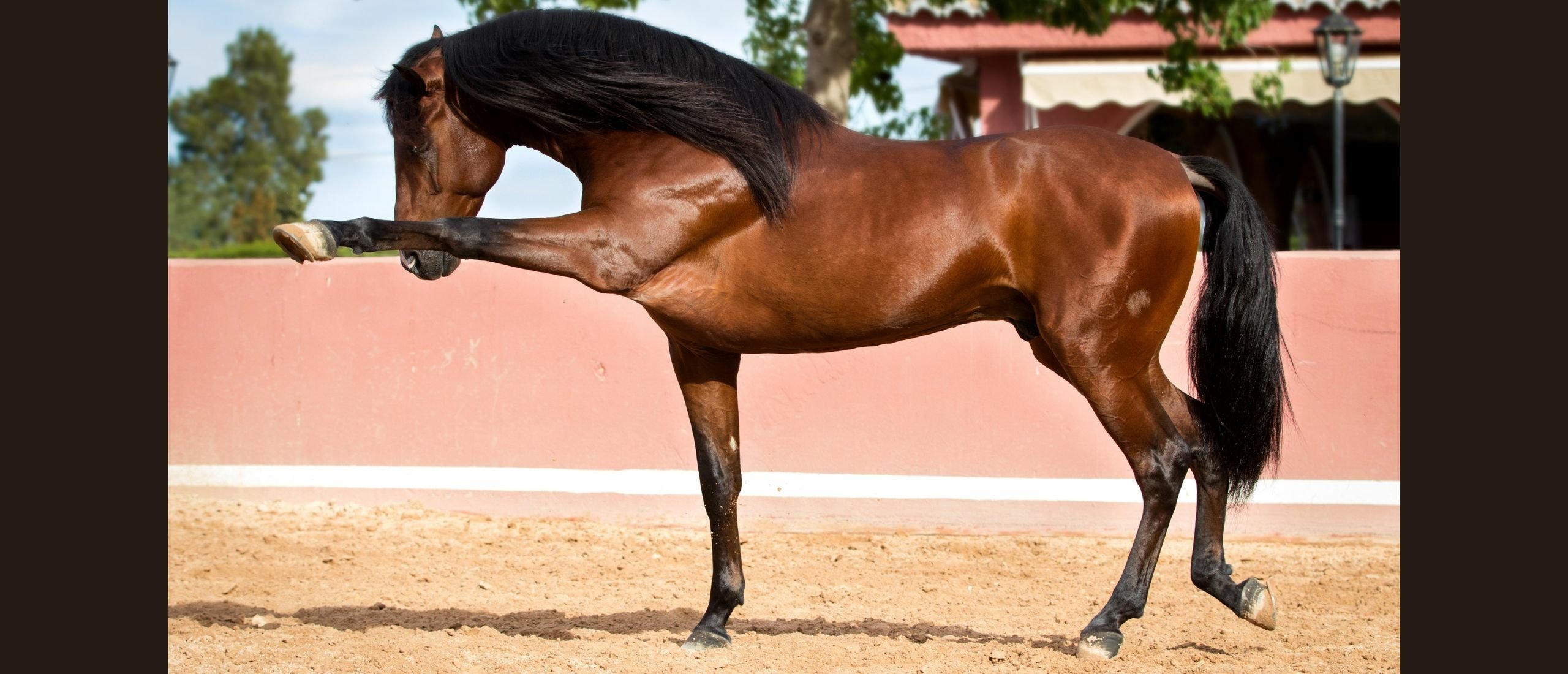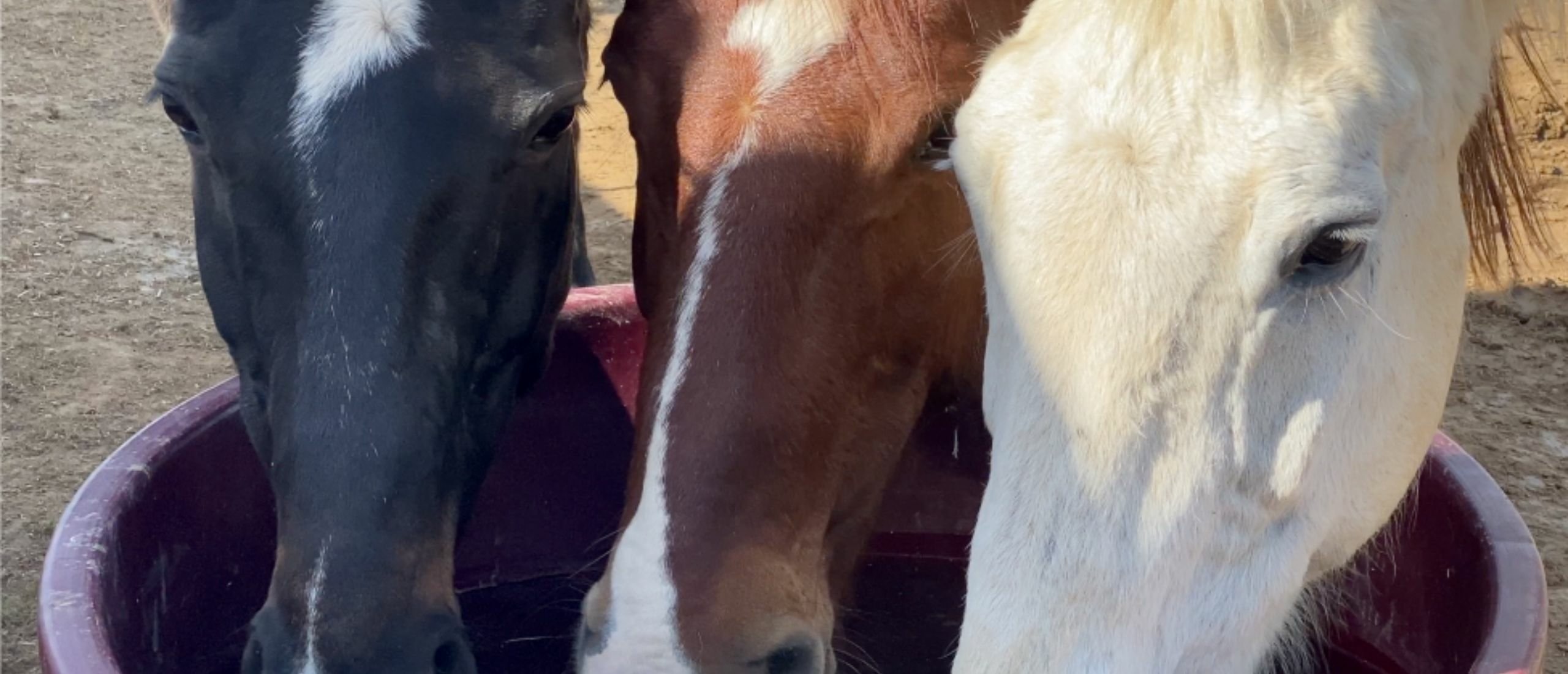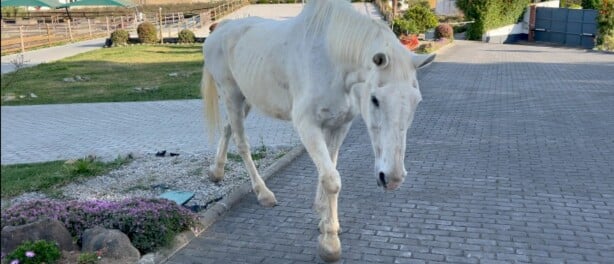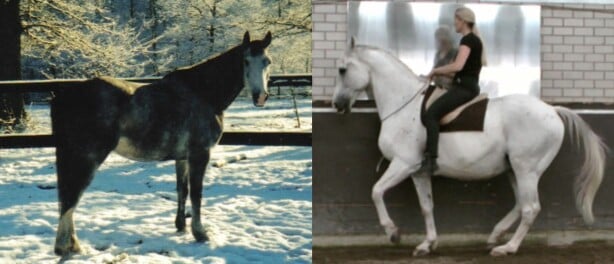When it comes to training horses – and also when it comes to fitness training for humans – there are two types of exercises:
1. Compound exercises
2. Isolation exercises
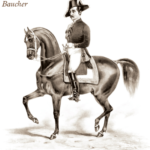
Already in the 18th and 19th century riding grandmasters favoured one over the other. For example, François Robichon de La Guérinière (1688–1751) and Gustav Steinbrecht (1808–1885) favoured the traditional and academical compound exercises and François Baucher (1796–1873) favoured and invented a lot of revolutionary and fancy looking isolation exercises (where his first method was rather harsch, but his milder second method is still used nowadays).
First, let’s have a look at the definition of compound and isolated exercises and then let’s address the benefits and drawbacks of each type of exercises, so we can make a conclusion at the end.
Definition of compound exercises
The definition of compound exercises is, that they trigger the whole body and multi major muscle groups and multiple joints are involved. During the exercises the whole body is connected, so the body stays in harmony and unity and while doing the exercise the essence and functionality is kept in mind, so they mimic the mechanics of movement that you want the horse to get better at, such as carrying weight. The goal of these exercises is to improve and increase:
- Mobility (which is a combo of flexibility and strength)
- Coordination
- Core strength and core stability
- Muscle building
- The performance in functionalities such as kicking, throwing, pushing, pulling, jumping, and most important in ST: carrying, so the horse can carry us in the most healthy way.
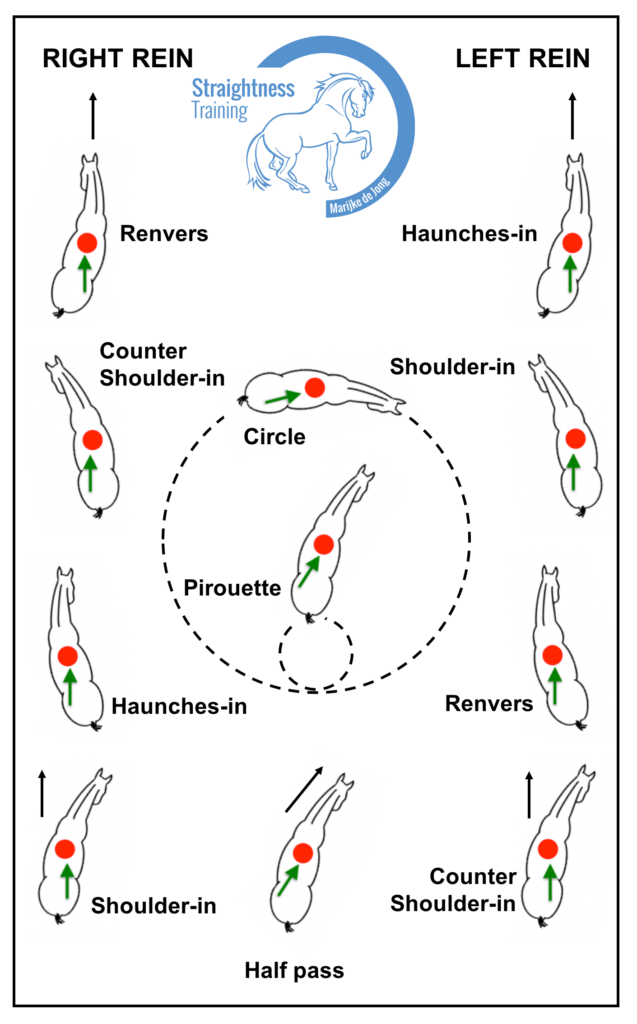 Examples in horse training:
Examples in horse training:
- Circle
- Shoulder-in
- Haunches-in
- Renvers
- Half pass
- Pirouette
- Piaffe
- Passage
- Levade
- School-halt as transition and touchstone (with bended hind legs)
Some examples in human fitness training (search on Youtube to find examples of needed):
- Chin up
- Bench press
- Deadlift
- Plank
Defininition of isolation exercises
The definition of isolation exercises is, that they target and isolate a single part of the body and trigger a single muscle group, where one joint is involved. The exercises don’t mimic the mechanics of movements that the horse needs to get better at. The goal and purpose is:
- To gain 100% control over the horse’s body and mind.
- To ‘spot treat’ a certain muscle group or body part.
- To teach and increase the technique of a single element of the compound exercise, in order to prepare that all elements can be integrated with quality, since it can be difficult to integrate all fundamentals of compound exercises at once.
- To show off - some isolated exercises look quite impressive, therefore you see a lot of them performed by animals in the circus.
Some examples in horse training:
- Head down
- Head in
- Jambette (pointing one front leg)
- Mountain goat (front legs stand still and the hind legs move closer to the front legs)
- Park out (the hind legs stand still and the front legs move forward)
- Disengage of the hind legs (with pivoting front legs)
- Spin and spinning rear (with pivoting hind legs)
- Belly lift / back lift
- Crunches & squats
- School halt as a trick, to strike a pose (with straight hind legs)
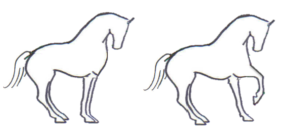
- Biceps curls
- Leg extensions
- Crunches
Benefits of isolation exercises
Practising isolation exercises has many benefits:
► Control and focus
Already in the 19th century, Baucher used isolated exercises to gain 100% obedience of the horse. By using isolated exercises, he could work the horse in standstill and he could work the front legs separately from the hind legs in order to eliminate the horse’s instinctive forces by suppressing these natural forces. Now his approach – which is called his first method - was a bit extreme, forceful and horse-unfriendly – which rather is a drawback than a benefit for the horse. And in his first method, Baucher did not do the isolated exercises for the benefit of the horse, but to get the horse 100% obedient so he could use the horses for the tricks and entertain the audience in the circus.
However, nowadays you can still see milder variants of these exercises that are used to gain control. One of them is the disengage of the hind legs, which is seen as a powerful control to settle and control a horse that is in a state of fight or flight. The disengage is used to reduce the power of the hindquarters and the ability to move forward, to reduce the instinctive emotional tendency to flee or fight and to get the horse’s focus back and to get the horse in a learning frame of mind. Now when a horse knows how to full disengage, it’s easy to make a half-disengage or quarter-disengage, and in ST these variants on the full-disengage are used as a half-halt to improve the stepping under on the circle or shoulder-in at liberty or to improve the thinking frame of mind of the horse.
► Quick results
Another benefit, is the short period of time you need to teach a horse an isolated exercise. Baucher was able to teach the high school movements as ‘tricks’ in 3 months. So you can very quickly teach a horse to do a certain movement or behavior.
For example, within a couple of days, you can teach a horse to point a front leg. It’s just a matter of reinforcing every slightest attempt in the right direction, and if you release, reward and relax first at the slightest try and then at the slightest better, the horse quickly knows what is to be expected from him and he will put effort in meeting your request. This is, because he can earn something in the process, so within a couple of days he will quickly offer you what you want.
► Helpful in the teaching phase
In ST we also use isolated exercises in the teaching phase to teach the beginner rider the basics in a simple, uncomplicated way. So we use the isolated exercise ‘forward down at a standstill’ to school the pressure/release technique with the rider and the isolated exercise ‘stelling/bending at a standstill’ to refine the process of yielding/searching even more.
You could see this isolated approach as preparatory ‘tests’ for the ‘pilot’ before he takes off the ‘plane’: it’s good to check if the required basics and solid foundation to build on are there. And if so, we immediately start working on integration of the lateral bending and forward down tendency in movement and let it work in unity with the stepping under of the inside hind leg. We call this the ‘LFS’ in ST and we work the L(ateral bending), F(orward down) and S(tepping under) in unity, so in a compound way, but at first, it’s advisable to teach the separate elements in an isolated way, before we start to integrate them.
► Useful in case of injuries Isolated exercises can be very useful in times that the horse has injured a leg or a certain body part. So if the horse for example can’t move, you can still do the stand still exercises . Tin the stable to help the horse to stretch the topline and to stretch to the left and to the right. This also brings variety to the situation of imposed box rest, which is good for the horse’s mind.
► Impressive Isolated exercises can also be just fun to do and to show to other people, because a lot of fancy tricks will impress other people, especially people who don’t know anything about horses. That’s why Baucher had such a success in the French circus, where people were impressed with the ‘mountain goat’ and ‘canter backwards’ and the ‘one tempi changes’. He also sold many educated horses to the Russian state circus where the horses entertained the Russian people.
Drawbacks of isolation exercises
Besides the benefits, there are also drawbacks when it comes to isolation exercises:
► Disconnection
When separate learned tricks as ‘head down’ and ‘head in’ are combined in movement without unity, something undesired might happen: the horse starts to move in a disunited way. Of course it might be difficult to see in the beginning if something is performed as a set of isolated and disunited tricks or if what you do with your horse mimics the mechanics of movement that you are trying your horse to get better at, in other words, if something is a ‘look-a-like’ or the ‘real deal’.
For example, at liberty, when ‘head down’ and ‘head in’ are put on cue and are just combined with movement as if you just combine a set of isolated tricks, the horse often looks disunited, where the amount of forward down and stelling/bending doesn’t relate to the stepping under in behind. The posture is produced mechanically and the head and neck carriage doesn’t arise organically out of proper biomechanics. Therefore, the horse often pokes his nose too much down, or it looks as if the horse moves in two or three parts, or as if he’s constructed out of two separate bodies.
It’s the same with creating a better posture yourself when sitting on a horse, for example if your instructor says:
- Head up
- Chin towards your neck
- Heals down
- Sit straight
- Keep your elbows close to your body
- Shoulders back
- Keep your thumbs up
When you do all these single things separately, you might end up very stiff and it might look very disunited. But if you use a whole picture, where you are for example asked to "imagine to be a tree and to grow and root to both sides where you touch the sky with your head and extend your legs so you can touch the ground with your feet", a better posture will arise organically and in unity and it will immediately look good, because your body is still in harmony.
► Instability and insecurity
Excessive bending of the neck at standstill has the risk in itself of creating instability, because of too much flexibility without strength. In his first method, Baucher used isolated exercises that violated the natural biomechanics, by excessively overbending the neck and spine of the horse and by moving the hind quarters around pivoting front legs. He did this for 100% obedience and because he saw the hindquarters as his ‘enemies’, so he wanted to eliminate the natural forces of the hindquarters. This resulted in a disconnection between the front end and hindquarters. Therefore, the weak hind quarters were no longer able to transfer the energy, through the spine towards the front. And this created instability, not only in the body, but also in the mind: the horses became very insecure, because the hind legs didn’t cooperate in unity with the front legs, as if they had separate wills.
► Disunity
You also see this disunity and disconnection when people are doing the Spanish walk with their horse in a disunited way: the front legs move very active, but the horse forgets to move the hind quarters, so he steps with the front legs forward, but the hind legs stand still, so he parks out, creates a hollow back, and only at maximum park out, the hind legs starts to move. So the horse doesn’t move in unity with all four legs.
► Excessive stress on legs and single joints
When you look at the disengage that is used nowadays: when you do for example too much disengage with your horse, where the horse pivots his front legs all the time, this might put excessive stress on the front legs, especially on the inside front leg, and that might seriously damage the front in the long run.
It’s the same with the spin, where the front legs turn around the pivoting hindquarters. So this exercise has the risk to put excessive stress on the hind legs and to damage the hindquarters in the long run. Also the spinning rear, where the horse rears and then spins, there's excessive stress on the hocks. As Steinbrecht already said: “There is no joint that can have more types of injuries, than the hock joint’”.
► Poor posture
|With isolated exercises there’s also the risk of creating a poor posture, for example the ‘mountain goat’ - which Baucher used to create ‘balance before movement’ - and the ‘park out’: The 'mounting' goat puts too much weight on the front legs and often creates a roach back, whilst the park out hollows the back, drops the underneck and puts stress on the lumbar region.
► Damage because of hyperflexion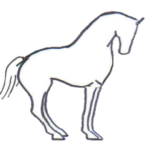 A roached back and overflexion of the lumbar area is often seen with horses who do the 'mountain goat, or the ‘crunches' or the tricked school halt. When doing these isolated exercises regularly, and for a period of weeks or months, the lumbar region can become stressed, painful or over-flexible due to the extreme and repetitive raising of the back in the lumbar area. There's also a risk of damaging the hyoid apparatus by overflexing the neck day after day, and this happens whether or not the overflexing is done with or without force of reins.
A roached back and overflexion of the lumbar area is often seen with horses who do the 'mountain goat, or the ‘crunches' or the tricked school halt. When doing these isolated exercises regularly, and for a period of weeks or months, the lumbar region can become stressed, painful or over-flexible due to the extreme and repetitive raising of the back in the lumbar area. There's also a risk of damaging the hyoid apparatus by overflexing the neck day after day, and this happens whether or not the overflexing is done with or without force of reins.
► Disharmony
When the focus is more on one part of the body then the other, this can also create disharmony. You can see that for example with human body builders, who train their upper body intensively - so they can show off at the beach - but don’t pay attention to their legs. These men have impressive upper bodies which are not in proportion with their thin legs.
► Lack of essence and functionality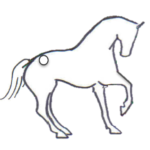
There’s also a risk that so called ‘gymnastic’ exercises are done without having the essence in mind. Let’s take for example the ‘school halt’: when this exercise is done as a ‘trick’, just to strike a pose, you often see stiff and straight hind legs, where the leg only pivots in the joint that connects the leg to the spine, but is not bending the other joints. 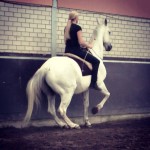 Now when you do the school-halt, it’s important to keep functionality in mind and to think “Does this mimic the mechanics of movement that I am trying to get my horse better at?”
Now when you do the school-halt, it’s important to keep functionality in mind and to think “Does this mimic the mechanics of movement that I am trying to get my horse better at?”
Now in ST we want our horse to get better at carrying, so we focus on increasing the ability to carry weight and in order to be able to take weight, the hind legs need to be able to bend in all seven joints of the hind leg.
Therefore we practice it as a 'transition' between the piaffe and levade and we use the variant with all for legs on the ground as a 'touchstone' when we go from trot or canter to halt, to test the strength of the hind legs. But doing the school halt as a trick - or the mountain goat, or the crunch, or squat - it creates the opposite: stiff hind legs, because the hind legs are not bended, the angles between the joints are not closed, and when your primary focus is on doing these ‘tricks’ during the training, the hind legs might lose their natural ability to bend. So the school halt as a ‘trick’ is in a way a caricature and ‘look-a-like’ of the school halt that is done as a transition or as a touchstone to check if the horse is ready for more collection, which means, carrying more weight in behind.
There are also interesting human examples when it comes to losing sight of the essence and functionality. Humans who do fitness training often do this because they want to get better at functionalities such as throwing, kicking, pushing, pulling or carrying something. But there are also humans who do fitness training in order to look good, for example, to have an expressive six-pack and pronounced quads. Now to be able to show off your human body, many isolated exercises are invented, for example the ‘leg extension’ (search on Youtube on ‘isolated leg extension’ if you need an example).
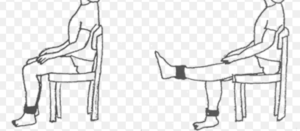 But when you want to get better at ‘kicking a ball’ because you are a football player, then doing isolated 'leg-extensions' (see picture) to strengthen your quads is probably not the best idea. Because:
But when you want to get better at ‘kicking a ball’ because you are a football player, then doing isolated 'leg-extensions' (see picture) to strengthen your quads is probably not the best idea. Because:
- You are seated when you do the exercise, when you kick you are standing.
- You are sitting onto the chair to stabilize yourself.
- You use only your quads and nothing else.
However, when you kick a ball, your whole body needs to move in coordination for you to execute your kick. So you will need coordination of the hamstrings to counter balance the explosive power of the quads, and the non-kicking leg needs to be a stable platform to launch the kick from, plus you need core strength too. So your whole body needs to be involved when kicking a ball.
Besides this, the leg extension exercise also includes the risk of excessive stress on your knees.
► Weak core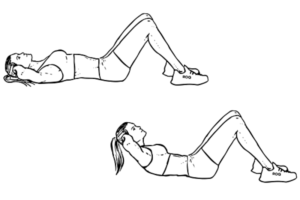
When it comes to humans, the isolated exercise ‘crunches’ (see picture) is outdated, because it’s an exercise that isolates the abdominals and during a crunch your core muscles are not moving in the way they are expected to work in real life. Therefore, it may create a weak core and poor posture, because it doesn't consider the whole body and deep muscles: crunches over-focus on surface muscles instead of deep core muscles, and the surface muscles are not the most important muscles for true core strength. So doing crunches - to 'spot treat' abs - is not the best way to train your core.
Plus working on the abs at the neglect of everything else can be ineffective and even dangerous, because crunches often create tension in the neck and even back problems in human bodies, because it compresses the lumbar spine and stress (and even herniate) the discs of the spine.
Deep core training acknowledges that the whole body is connected. Your body is much better off with training it in unity and by training the whole core, which is not only abs, but also deeper muscles, small stabilizing muscles, back muscles, glutes and hamstrings!
So when I train my own body, I prefer to use compound exercises that involve lots of different muscle groups like push-ups, chin-ups and deadlifts. These exercises ‘force’ me to work many muscle groups at once and they stabilize and strengthen my core muscles. So I don’t do isolated leg extensions for my quads or crunches for my abs, and the great thing about abs is you work those muscles in almost every compound exercise you do!
And the same applies to horses: If you want to train true core strength and core stability - which is needed to be able to do collected exercises and movements such as the piaffe, pirouette and the school-halt as transition - you need to train the horse’s whole core, not only the abs, but also deeper muscles, small stabilizing muscles, back muscles, glutes, and hamstrings, as done in compound exercises.
François Robichon de La Guérinière already said in his book:
“Practice – stripped of sound principles – is nothing more than routine that only results in a false brilliance that fascinates the demi-connoisseurs, who are often amazed by the horse’s kindness, rather than by the rider’s skill.”
Benefits of compound exercises
The advantages of compound exercises are:
► Perspective on functionality
Compound exercises are based on the sound principles of healthy biomechanics. They keep the essence and functionality in mind when doing exercises: when it comes to functionality and motion, you have to think about at what movement you or your horse want to get better at: kicking, throwing, jumping, pushing, pulling, carrying?
Let’s look at a human first, to make the concept of functionality easy to understand:
- When you want to jump, you first have to go down. If you don’t, you won’t jump as high as you can.
- When you want to throw a ball, your arm has to go backwards, before you can throw something forward. If you don’t, the ball won’t get far.
- When you want to kick a ball, your leg first goes backwards, before it executes the kick forward.
So every muscle should both lengthen and contract. In efficient and functional movement, you will never see contraction of any muscle prior to lengthening and vice versa. Fluid movement utilizes the elastic energy created by the lengthening to bounce back and go in the opposite direction. Once it's at the other end it bounces back again and this continuous reciprocation of movement is why walking is so easy for us to do.
That’s why Steinbrecht said: “Ride your horse forward and set it straight”, so he recommended ‘movement before balance’ (which is the opposite of Baucher, who recommended ‘balance before movement’).
► Working the body as a whole and in unity
Compound exercises make sure that the horse’s body develops in harmony and unity. They help the horse to get ready for carrying his own weight plus the extra weight of the rider in a healthy way, so he can perform as a riding horse until an old age.
► Compound exercises are a true muscle builder
Since there are approximately 700 skeletal muscles in the whole body of the horse, which produce movement, create stability and maintain the posture, compound exercises are great muscle builders, because they work multiple muscle groups and chains.
During the compound exercises the muscles will relax and contract, and while they contract they will shorten (concentric muscle activity) and lengthen (eccentric muscle activity) or keep the same length (isometric muscle activity). All three types of contraction helps the horse to build a musculature body and the more muscles you can effectively train in a given exercise, the more overall muscle you can build as a result.
► Progressive process Gradually the horse can progress by following the logical order of progressive and compound exercises:
- It starts with the circle, where the first three keys of ST - the L(ateral bending) of the body, the F(orward down) down tendency of head and neck and STtepping under) of the inside hind leg, the LFS - are worked in unity. The three keys are closely connected, one cannot exist without the others and the three keys must be trained in harmony to not lose the gymnastic effect. That’s why we use the terminology ‘LFS’, to avoid the pitfall of isolation and to work the keys in a compound way and as a unit.
- Next, the exercises shoulder-in and haunches-in are practiced, with the main focus on working all muscles and all joints in the front and hind legs, whilst not ignoring the first three keys of ST, so a lot of superficial and deeper muscles in the whole body are involved in these exercises. Also the derived lateral movements, trigger the whole core and encourages the horse to work many muscle groups, so these exercises make sure that the whole body is connected and works in unity and they improve the coordination of all four legs. This way, the horse gets ready to carry most weight on the hind legs so it can carry the extra weight of the rider in the healthiest way.
- Finally, collection in walk, trot and canter is used to increase the mobility and carrying ability of the hind legs even more, to free the fragile front legs even more.
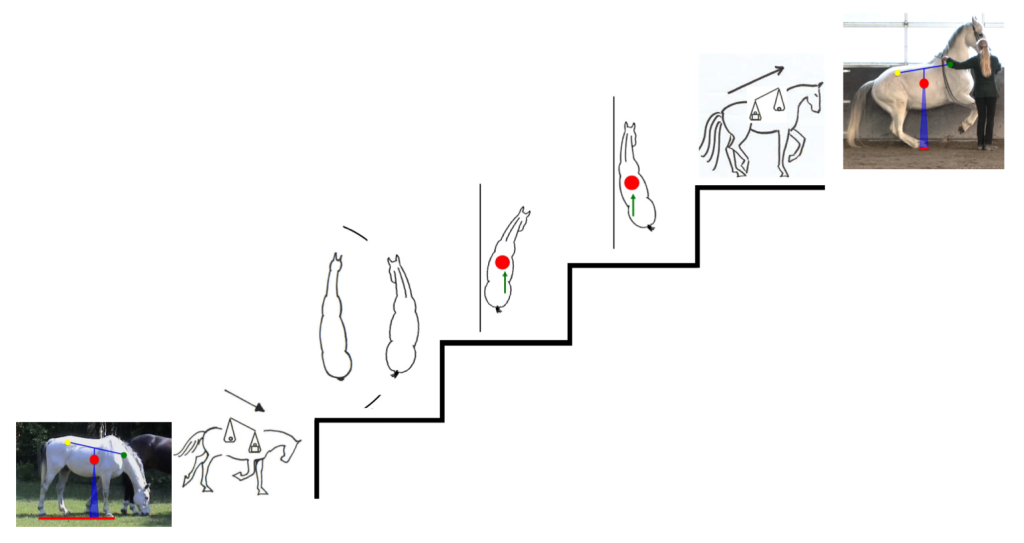 ► Increased mobility and carrying ability
► Increased mobility and carrying ability
The compound exercises increase the mobility of the horse, which is the combination of flexibility and strength, which you see for example in the pirouette: the horse is very supple in the hind legs, he can bend them easily in all joints, but he’s also very powerful in the hind legs, and this combination of flexibility and strength makes that he’s very mobile and that he can quickly make a turn on the haunches. And he can do this without tossing himself around, or without throwing himself in the turn, because he has enough core strength, core stability and coordination, to carry his own weight and that of the rider in a balance way in this difficult exercise.
► Increased core stability and strength
Because of the isometric muscle activity in most lateral movements and in collection, the horse’s core is trained automatically. Because the great thing about the lateral movements, is that you work the deep core muscles in almost every exercise you do. And remember, the core doesn’t exist of only only abs, but also of deeper muscles, small stabilizing muscles, back muscles, glutes and hamstrings, and all these are trained by executing the compound exercises.
► Dressage for the horse
The compound exercises are used for the benefit of the horse. There the saying of the old grandmasters comes from: “The dressage is for the horse, the horse is not for the dressage”.
Drawbacks of compound exercises
The disadvantages of compound exercises are:
► It takes time
The drawbacks of compound exercises are that the first signs of achievement won't appear in the first couple of weeks; you have to think months and years. But as Steinbrecht already said:
“As long as a horse is of flesh and blood, just like with the 'philosopher’s stone' people will search in vain for a tool to make gymnastic exercises redundant.’'So there is no 'quik-fix
'. To give you an example: 2 years ago I started preparing for my 'ST for the rider' program, because I think it’s invaluable to experience the process of muscle development and the process of gaining more core strength and core stability from the inside out, in order to understand our horse better.
Now I already did Pilates for years - which consists of both compound and isolation exercises - but at the beginning of 2015, I started to intensify my strength training by lifting weights, so I could relate in a better way to my horses: they have to lift not only their own weight, but they have to also carry me, which causes an additional weight of 70 kilo/150 pounds.
So I started doing all kinds of gymnastic lift training myself and one exercise was the compound exercise 'chin up’: only after 2 years of refining and polishing my technique and by strengthening my back muscles and arm muscles, I was able to lift myself 2 times in a row (2 reps) without the help of elastic bands and I could do this 5 times in a training session (5 sets of 2 reps). So that didn’t happen overnight!
Nowadays, I can also do the compound ‘deadlift' with 70kg, for 6 times in a row, so I can carry not only my own weight, I can carry double my own weight. But in the beginning I could not even do this exercise properly with zero extra kilos, because my technique was not good and I had not enough core strength and stability. So I needed to do a whole set of other progressive exercises first, with unilateral lunges and split squats where you work only one leg at a time - you can compare this to doing shoulder-in and haunches-in, where you train a hind leg in a different function (as inside hind leg or outside hind leg) - before I could finally do the ‘levade' and carry double weight with both hind legs at the same time!
So yes, it takes time, I know this from the inside-out, but all good things take time and are worth waiting for!
► It takes patience and persistence
Because it takes time, it happens, that newcomers in ST lose patience, perseverance and interest and prefer to cruise the trails like they did before. Or they jump to another method that mainly uses isolated exercises, because results will be visible already in the first couple of days, and people like instant gratification.
► Imbalanced growth
Another drawback is, that compound exercises can create imbalances in the growth and progression of the various muscles involved, if the horse is mostly worked on the ‘easy side’. So it’s very important to ‘observe first, produce later’ and to train the difficult first and to end on the difficult side, so that you at least train the difficult once more, to counteract the natural asymmetry.
► Too slow
Teaching compound exercises is about creating new neurological pathways, because the horse will learn to move in a more balanced way, as an alternative for the ‘crooked’ way. Another way to explain the creation of a neurological pathway is ‘creating a new habit’. And to create a new habit it’s helpful to do a new movement in ‘slow motion’ so the body and brain have time to create a healthy new way of moving.
But pitfall of many riders is, to stay too long in the teaching phase: they keep moving slow while the horse knows the exercises for a long time. So once a horse knows how to move with quality in balance, suppleness and shape, you need to start moving in a normal tempo and regular rhythm so the horse will move with nice, long, strides.
► Too much, too long, too soon, too often
One more drawback is, when you lengthen, contract or load the muscles of your horse too much, too long, too soon, too often or in a sudden way, you increase the risk of injuries, joint problems and other undesirables.
And especially the moment the horse is able to take weight in behind and to collect itself - by shifting the center of mass towards the hind legs - there's a risk of focusing on too much collection: then you might lose the forwards swinging of the hind leg, ending up with short steps. So it's important to not only strive for 'collection', but also for 'connection' where the hind legs are able to connect with the center of mass, by stepping under the center of mass with a nice swing forward in a normal tempo and regular rhythm. Only when there's a good connection, we can shift the center of mass towards the hind legs and collect the horse. So we have to give attention to both connection - hind legs towards center of mass - and collection - center of mass towards the hind legs - in equal doses.
Steinbrecht already said: "Ride your horse forward and set it straight", where the forward doesn't mean 'fast' but it's about the swinging forward in a forward direction of all four legs. 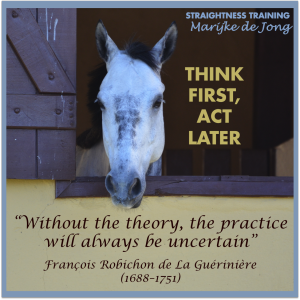 So it’s very important to use the concepts of the old grandmasters, also the concepts of ‘think first, act later’ and ‘observe first, produce later’ so you can make an appropriate ‘fitness scheme’ for your horse.
So it’s very important to use the concepts of the old grandmasters, also the concepts of ‘think first, act later’ and ‘observe first, produce later’ so you can make an appropriate ‘fitness scheme’ for your horse.
► Self-thinking rider needed
Another drawback is, that the human needs to develop from ‘just a rider’ to a real horse trainer, so the rider can become the personal fitness trainer of the horse. So the rider has to be willing to put the time and effort in schooling and education himself so he can think for himself and create a proper training scheme for the horse.
► Mastery of oneself required
Along the way, the rider has to be willing to do some self-mastery.
As Steinbrecht formulated it: “If the art were not so difficult we would have plenty of good riders and excellently ridden horses, but as it is the art requires, in addition to everything else, character traits that are not combined in everyone: inexhaustible patience, firm perseverance under stress, courage combined with quiet alertness. If the seed is present only a true, deep love for the horse can develop these character traits to the height that alone will lead to the goal.”
And it’s about mastering self-control and there has been done scientific 'marshmellow' studies, in which children were offered a choice between one small reward provided immediately or a larger later reward if they waited for 15 minutes. In follow-up studies, the researchers found that children who were able to wait longer for the preferred rewards tended to have better life outcomes… hmmmm, something to think about… ;)
Conclusion
Every rider and every grandmaster has his own ideals. And all riders know WHAT they do. A number of riders know HOW they do it. Fewer riders know WHY they do what they do. Most of the time it’s the lack of knowledge that causes that riders know WHAT they do but they do not know WHY they do it and what the consequences can be of what they do. T
hat’s why - when the first signs of achievement with compound exercise don't appear in the first couple of weeks - newcomers in ST lose patience, perseverance and interest and they might feel attracted to methods that show impressive isolated exercises that can be reached within a couple of weeks, even days! Remember the marshmellow test!
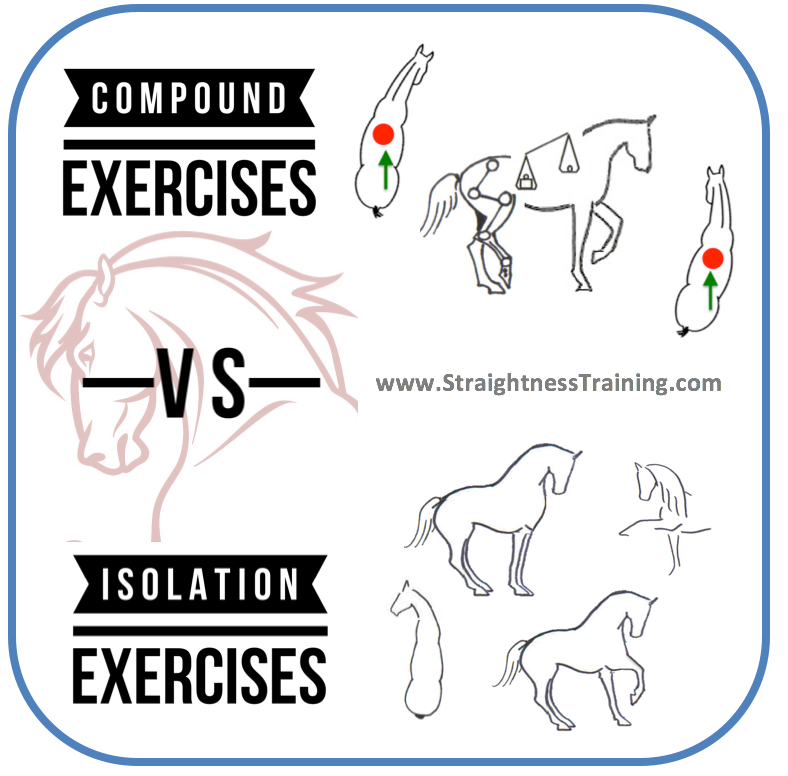 But by knowing the benefits and drawbacks of both the compound and isolation exercises, you are now able to make up your mind and determine what suits your goals, dreams, desires and ideals best.
But by knowing the benefits and drawbacks of both the compound and isolation exercises, you are now able to make up your mind and determine what suits your goals, dreams, desires and ideals best.
Also in ST we made up our mind, and we believe that there is a time and place for every tool in our tool kit. So a secondary focus on isolation exercises is fine, but no matter how you look at it, when you do Straightness Training, compound exercises deserve much more attention than isolation exercises, because they keep the essence and functionality in mind and therefore deliver far better and healthier results on the long run.
In ST we don’t underestimate the importance of compound exercises:
- Compound exercises increase performance by keeping the essence in mind and the perspective on functionality. This way, the horse is getting ready to carry most weight on the hind legs and the horse’s body is well prepared for carrying the extra weight of the rider.
- Because the goal of compound exercises is to increase both flexibility and strength and to improve the carrying ability of the horse, compound exercise will deliver far better and healthier results than isolation exercises.
- Compound exercises are a much more effective muscle builder.
I encourage you to just find out from the ‘inside out’ by going to the gym yourself ;) !

